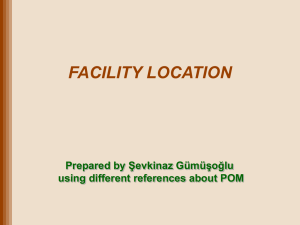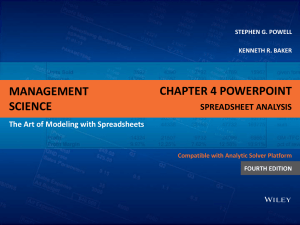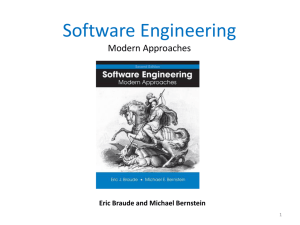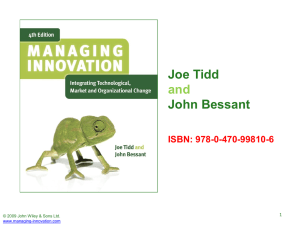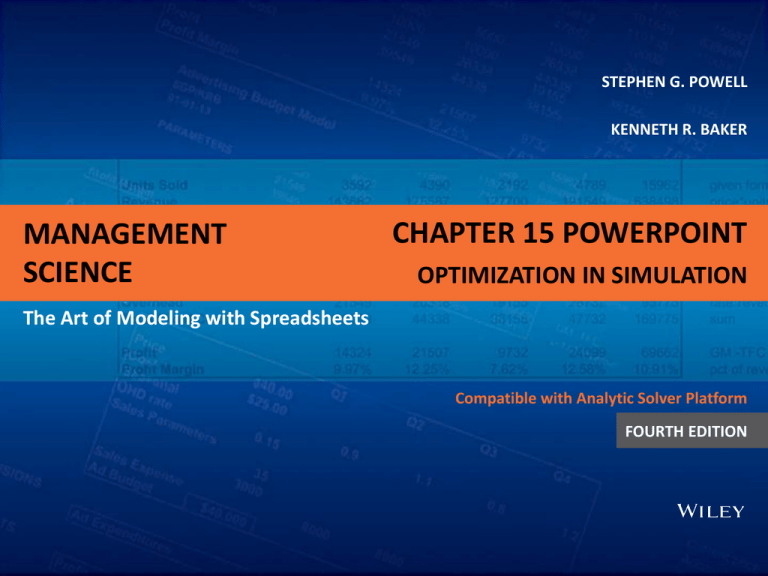
STEPHEN G. POWELL
KENNETH R. BAKER
MANAGEMENT
SCIENCE
CHAPTER 15 POWERPOINT
OPTIMIZATION IN SIMULATION
The Art of Modeling with Spreadsheets
Compatible with Analytic Solver Platform
FOURTH EDITION
INTRODUCTION
• We would like to marry the power of optimization to
identify the best decision variables with the power of
simulation to describe outcome distributions.
• Unfortunately, the optimization approaches using Solver
are all based on the premise that the objective function
can be measured deterministically.
• But in simulation models the objective function is the
expected value or some other function of a random
variable.
• Analytic Solver Platform can optimize these models as
well.
• However, a number of issues arise that do not arise when
optimizing deterministic models.
Chapter 15
Copyright © 2013 John Wiley & Sons, Inc.
2
OPTIMIZATION WITH ONE OR TWO DECISION VARIABLES
Chapter 15
Copyright © 2013 John Wiley & Sons, Inc.
3
OPTIMIZATION WITH ONE OR TWO DECISION VARIABLES
• Two outcomes of this model example are of particular interest: the
profit contribution and the number of leftover units.
• To record the mean contribution on the spreadsheet, place the
cursor on cell C22. Then select Analytic Solver Platform►Simulation
Model►Results►Statistics►Mean, and select the contribution cell
(in this case, E22). This places the formula =PsiMean(C20) in cell
E22.
• Although both outcomes are important, we take the maximization
of mean contribution as our primary objective.
• Our approach is to maximize mean contribution subject to
secondary consideration for the mean number of leftover units.
Chapter 15
Copyright © 2013 John Wiley & Sons, Inc.
4
DISTRIBUTION OF PROFIT CONTRIBUTION
Chapter 15
Copyright © 2013 John Wiley & Sons, Inc.
5
DISTRIBUTION OF LEFTOVER UNITS
Chapter 15
Copyright © 2013 John Wiley & Sons, Inc.
6
GRID SEARCH
• In a grid search, we select a series of values we wish to
test for a decision variable, and we run the simulation at
each of these values.
• When our model is particularly simple, there is an
efficient approach to grid search.
• The trick is to replicate the model for each value of the
decision variable we wish to test.
Chapter 15
Copyright © 2013 John Wiley & Sons, Inc.
7
OPTIMIZING USING SIMULATION SENSITIVITY
• Simulation sensitivity can be used for optimization when
we have one or two decision variables.
• In the example of an apparel order, we first plot the
mean contribution over a range of order quantities, then
display the minimum and maximum along with the
mean.
Chapter 15
Copyright © 2013 John Wiley & Sons, Inc.
8
SENSITIVITY OF MEAN CONTRIBUTION TO ORDER QUANTITY
Chapter 15
Copyright © 2013 John Wiley & Sons, Inc.
9
SENSITIVITY OF MEAN, MINIMUM AND MAXIMUM
CONTRIBUTION TO ORDER QUANTITY
Chapter 15
Copyright © 2013 John Wiley & Sons, Inc.
10
SENSITIVITY OF CONTRIBUTION TO ORDER QUANTITY AND PRICE
Chapter 15
Copyright © 2013 John Wiley & Sons, Inc.
11
OPTIMIZING USING SOLVER
• If we want to determine the optimal order quantity with
more precision than a coarse grid search provides, we
have two options:
– Refine the grid (using simulation sensitivity with a larger
number of Axis Points)
– Use optimization directly (invoking Solver).
Chapter 15
Copyright © 2013 John Wiley & Sons, Inc.
12
STOCHASTIC OPTIMIZATION
• When the problem involves three or more decision variables,
and possibly constraints as well, grid search has limited
usefulness.
• We then turn to more sophisticated methods for identifying
optimal decisions when the objective function is based on
probabilistic outcomes.
• Solver offers us an alternative to using the PsiMean function.
• We can designate the output cell as the objective.
• This output cell contains a distribution, so we must tell Solver
which aspect of the distribution we wish to maximize or
minimize.
Chapter 15
Copyright © 2013 John Wiley & Sons, Inc.
13
CHANCE CONSTRAINTS
• A chance contraint imposes a restriction on a tail
probability in the simulated distribution, or on a function
related to that probability.
• We can enter a chance constraint into a Solver model by
creating a cell to represent the 10th percentile of the
distribution.
• If the 10th percentile is negative, then more than 10
percent of the distribution falls below zero—that is, the
probability of a loss is greater than 10 percent.
Chapter 15
Copyright © 2013 John Wiley & Sons, Inc.
14
TWO-STAGE PROBLEMS WITH RECOURSE
• In a typical application of simulation, decisions must be made
before the uncertain outcomes become known, however it’s
possible that certain decisions can be made after some
uncertainties have been resolved.
• When decisions can be made after uncertainties are resolved,
we are better off if we take those results into account.
• If we ignore the option to act later with more complete
knowledge, we must make our decisions based on all the
uncertainties.
• If we can make our decision after we know the outcome of an
uncertain event or parameter, we can match our decision more
closely to that outcome and eliminate some of the risks.
Chapter 15
Copyright © 2013 John Wiley & Sons, Inc.
15
SUMMARY
• Simulation is primarily a way to describe the range of
uncertainty in the results of a model.
• Simulation models with one or two variables can be optimized
using a variety of techniques.
• Grid search is the general name for a procedure in which we
evaluate the objective over a range of values of the decision
variables.
• Grid search can be automated easily using the Simulation
Sensitivity tool.
• To optimize simulation models with three or more decision
variables requires the use of Solver.
Chapter 15
Copyright © 2013 John Wiley & Sons, Inc.
16
SUMMARY
• Two-stage problems with recourse are characterized by a
three-step sequence consisting of:
1. Determining the value of strategic decision variables.
2. Observing random outcomes.
3. Determining the values of tactical decision variables.
• In these problems, we first make decisions for the long run,
then we learn how random occurrences are resolved, and
finally, we make short-run decisions within the limitations
imposed by our previous long-run decisions.
Chapter 15
Copyright © 2013 John Wiley & Sons, Inc.
17
COPYRIGHT © 2013 JOHN WILEY & SONS, INC.
All rights reserved. Reproduction or translation of
this work beyond that permitted in section 117 of the 1976
United States Copyright Act without express permission of
the copyright owner is unlawful. Request for further
information should be addressed to the Permissions
Department, John Wiley & Sons, Inc. The purchaser may
make back-up copies for his/her own use only and not for
distribution or resale. The Publisher assumes no
responsibility for errors, omissions, or damages caused by
the use of these programs or from the use of the information
herein.
17 - 18





